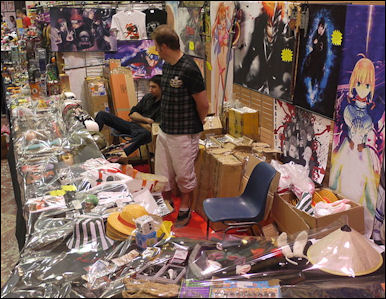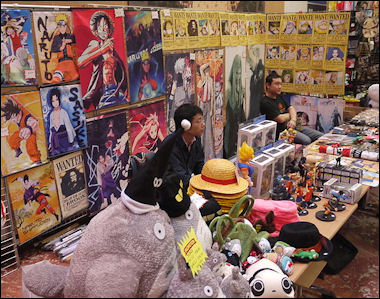OVERSEAS MANGA AND ANIME EVENTS
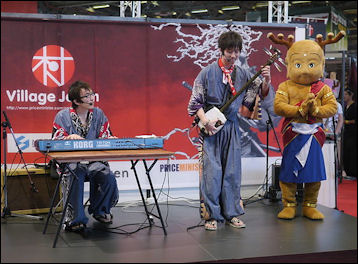
Japan Expo in 2011 Anime and manga expos are overseas events where fans of Japanese pop culture such as anime, manga, cosplay, fashion and music can get together. There are sort of like Trekie conventions. The larger North American anime conventions feature artists and voice actors from Japan and the United States as celebrity guests, screenings, panels and live performances alongside booths offering merchandise and promotional paraphernalia. Cosplay is often the biggest draw.
Takamasa Sakurai wrote in The Daily Yomiuri, “I estimate there are well over 2,000 events introducing Japanese pop culture worldwide. Although the Japan Expo in Paris and Anime Expo in Los Angeles are the two largest annual events that introduce Japanese pop culture overseas, hundreds of similar events are held in various parts of the world. [Source: Takamasa Sakurai, Daily Yomiuri, July 22, 2011]
In a survey I carried out in conjunction with the Foreign Ministry last year, I found there were well over 500 medium-scale events with anime, fashion, music and other Japanese pop culture themes. Besides these, more than 100 large events attracted over 10,000 visitors. The Japan Expo and the Anime Expo both attracted more than 100,000 visitors earlier this month. The survey I participated in did not include dojinshi fan manga publication events that are often held in China, nor those organized privately overseas that are not recognized internationally.
There are cosplay events in Johannesburg and, although the organizers say their events are very small, many similar events in other countries have grown over the years.
J-Fest in Moscow
The Japan Pop Culture Festival is a manga and anime event in Moscow. Organized through the Japanese Embassy in Moscow and launched at a Moscow movie theater in November 2009, it aims to introduce highlights of contemporary Japanese culture such as Harajuku-kei Gothic and Lolita fashion, visual-kei, pop idol music and songs used in anime. At the 2011 event there were young anime fans lining up for hours in freezing weather to see a special screening of “Evangelion: 2.22 You Can (not) Advance” and watched a catwalk show with Russian models, dressed in outfits designed by popular Harajuku fashion labels. The event was centered on anime, fashion, video games and music, and attracted about 3,000 people.[Source: Takamasa Sakurai, Yomiuri Shimbun, April 1, 2011]
Takamasa Sakurai, one of the organizers of the event wrote in the Daily Yomiuri: At the first J-Fest event, many people lined up for more than five hours in freezing temperatures just to watch Evangelion 2.22: You Can (Not) Advance, while girls cheered for Harajuku-kei fashion shows. I was so overwhelmed by young Russians' love for Japan that I was almost in tears. [Source: Takamasa Sakurai, Daily Yomiuri, December 23, 2011]
The third J-Fest attracted 13,000 people, more than four times the number that attended the first event. One fan, a 27-year-old male graduate student who is a big fan of Morning Musume and other Japanese idol groups, had taught himself to speak proficient Japanese and is a good example of the saying: "Suki koso mono no jozu nare" (You'll be good at what you like.) [Source: Takamasa Sakurai, Daily Yomiuri, December 9, 2011]
The Morning Musume fan introduced two of his female friends, aged 16 and 20. The two girls work part-time at a maid cafe, which opened two months ago in Moscow. The three Russians said they mainly communicated via the Internet.
There is a fair number of manga and anime fans in Mexico. In Jalapa young women call themselves otaku and are avid readers of “Shonen Jump”.
Anisama Anison Festival in Shanghai
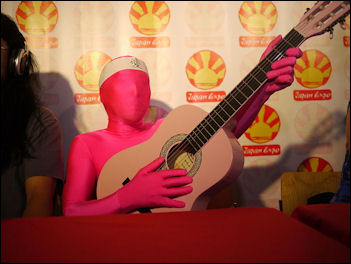
Japan Expo in 2011 More than 8,000 young Chinese anime fans gathered in February 2001 for the first festival outside of Japan to celebrate the anime theme song genre known as anison. Anisama has been one of Japan's best-attended annual anison concerts since making its debut back in 2005. Anisama in Shanghai — Only One — was initially planned for November 2010, but was postponed for three months due to tensions between China and Japan [Source: Takamasa Sakurai, Yomiuri Shimbun, April 29, 2011]
Takamasa Sakurai wrote in Yomiuri Shimbun: “Anison fans in China appeared to have been waiting with baited breath. The venue, Shanghai Grand Stage, was packed. The hall was hot with excitement, and was kicked up a notch when May'n sang one of the songs she did for Sheryl Nome, a pop idol from the animated series Macross Frontier. What also struck me was how well the audience seemed to understand Japanese. The audience seemed to comprehend what the singers were saying.”
The massive audience sang in unison with A Cruel Angel's Thesis, the Neon Genesis Evangelion theme song. Previous experience had already shown me that young Chinese love the track, too; it's the most popular karaoke anison in Japan. Still, I was moved and excited by the overpowering chorus. Headlining the festival was singer Hironobu Kageyama. I had been aware of the singer's popularity abroad for singing the theme tracks for Dragon Ball Z or Saint Seiya, but this was the first time I'd seen him outside Japan.
Japan Expo in Paris and Other European Events

Japan Expo in 2011 More than 180,000 showed up at the four-day Japan Expo in Paris in July 2010, compared to 3,200 in 1999. Other major European events include Japan Expo Sud in Marseilles, which attracted 30,000 people in 2009, Salon del Manga in Barcelona, which atracys 60,000 to 70,000 people, and Romics in Rome. In 2010, a manga exhibit featuring original drawings from “One Piece” and “Dragon Ball” opened at a modern museum in Istanbul.
Now in its 11th year, Japan Expo audience numbers are inching toward that of the Paris Motor Show, an international event that attracts an enormous number of visitors. France is arguably the biggest center for Japanese culture outside of Japan. One European mangaka told pop culture diplomat Takamasa Sahurai, “It is difficult to make a living as a manga artist in Italy, but not in France . Because France is the kind of country where literary work and manga sit side by side on the same newspaper page.”
A popular event at Japan Expo Sud in Marsailles is the Karaoke Party Time in which hundreds gather to sing popular theme sings such as the one from “Naruto” in Japanese and image of the show appear on a large screen.
The Polymanga anime, manga and video game festival in Lausanne, Switzerland is popular with cosplayers. The first event drew 6,000 fans. The one in 2010 attracted more than 16,000 people. Those that participated in the cosplay competitions are required to use hand-made costumes. One participant who spent six months making her costume and rehearsing her act told AFP, “I always liked dressing up.”
Japan Expo in Paris in 2012
Describing the 13th Japan Expo in Paris in July 2012, Takamasa Sakurai wrote in the Daily Yomiuri: My first Japan Expo was in 2008, and it drew fewer than 100,000 visitors. This year's event attracted more than 200,000. The manga and anime event was launched for and by Parisians, born of their own need to buy, see and talk about their love of Japanese animation. This latest event saw a huge number of Japanese people and companies, more than I could have imagined four years ago. Fashion retailer Uniqlo collaborated with One Piece to release products, while anime-related-goods shops, "B-class gourmet" vendors and local government tourism booths from Okinawa and Fukuoka prefectures could be spotted. I even came across some friends from Japan. [Source: Takamasa Sakurai, Daily Yomiuri, August 3, 2012]
I was personally happy to see many Japanese dojinshi (self-published magazines) mangaka and illustrators in attendance this year. The number of dojinshi booths has rapidly increased over the years. Most of the mangaka whose works I found to be excellent are Taiwanese, and their booths are always crowded. Whenever I see such crowds, I want more Japanese dojinshi artists to try their luck abroad. That's why I was very happy to see so many Japanese artists--many of them women--this time around.
The reason why Japan Expo attracted so many visitors was that "fashion" was one of the themes of the anime and manga event. Runway shows featuring Tokyo's Harajuku-style brands have been held every year at a big hall with a capacity of more than 10,000. Kyary Pamyu Pamyu was the headliner this year. She held two concerts and a Harajuku-style fashion show.
Her performance embodies the concept of "Japan," filled with the kawaii-ness and originality that people outside Japan encounter via Japanese fashion, music and anime. I feel it is important to share the precious essence of Japanese pop culture with several thousands of French people through Kyary's shows. Participants from the Japanese music and fashion industries seemed to be having the same experience as I do. Joining in Japanese cultural events overseas is an effective prescription for Japanese to feel better. "I didn't know that Japan is loved this much," said one Japanese participant.
Anime and Cosplay in Australia
Reporting from Sydney, Daniella Doughan of Jiji Press wrote: The popularity and availability of anime and Japanese pop culture have exploded in Australia with the rise of social media, online forums and specialty screening services. The increase and improvement in technology allow fans to connect with each other, watch their favorite episodes and easily plan and attend events. [Source: Daniella Doughan, Jiji Press, November 16, 2012]
Recently, anime fans were out in force in Sydney to attend Animania--a festival celebrating anime, games, manga and Japanese pop culture. At the two-day event, which included a cosplay competition, a game zone and karaoke, it was the commitment of those attending to dress up in costumes that really stole the show. The majority of fans were dressed as characters from Black Butler, Pokemon and One Piece, as well as the blue-haired vocaloid Hatsune Miku.
Even though there was an overwhelming response to attending in costume, there were only three acts in the competition--a disappointing turnout. Kayla and Jade, 16, both from Canberra, were dressed in full costume, complete with colored contact lenses and wigs. They chose not to enter the competition because "there are a lot of outfits here better than ours." Despite the reluctance to compete, most fans gave the same reason--to have fun--for being at the event. Animania was also an opportunity for fans to meet other fans, check out their costumes and participate in some of the activities on offer. Nikki and Keria, 23, said they took two months to make their cosplay outfits for Animania. "The most fun is meeting different people. We have been into anime since 2004. We started watching it on TV here.”
Luke Halliday, an editor and anime specialist at Capsule Computers, an Australian media company that delivers video game, entertainment, anime and pop culture news, says the first anime appeared on Australian TV in the 1970s and '80s with Astro Boy and Robotech. However, it really took off in the mid-1990s after Sailor Moon was broadcast and gained a cult following, paving the way for Dragon Ball Z, Pokemon, Naruto and One Piece.
Brad Merriel and Hansen Setiawan own the Anime at the Abbotsford--a specialty anime store in Sydney that focuses on action figurines. They opened the store in 2007 and have never looked back. Merriel says that the opportunities for anime fans here are amazing and cosplay is growing at a rapid rate. "It's getting a lot bigger, cosplay is getting more popular." Anime clubs can be found all over, from Facebook to universities. There are a lot of outings, get-togethers, cosplay picnics and treasure hunts, he says. He believes the increase in popularity is due to a number of factors. Firstly, there is a constant stream of new anime being released, so there is more content being produced and distributed. Secondly, the content has spread and is now more accessible in Australia.
Finally, the negative outcast image long associated with gaming and anime seems to have lifted. Video game fans, in particular, have had a stereotypically unfashionable representation in Australia. However, this appears to be shifting so that it is more widely acceptable to like and enjoy anime and gaming now. However, things are not all rosy for this subculture. One recurring problem in the anime industry in Australia is the high volume of counterfeit goods. This is one factor that prompted Merriel and Setiawan to open their store. "A lot of the places are selling fakes. I was having a lot of problems, I had to buy them [anime goods] online or on eBay," Merriel says. The authenticity of these products is almost impossible to judge when buying online. Moreover, genuine items are unaffordable to the many young fans that the industry attracts.
Halliday echoes Merriel's concerns. He says the Australian anime industry has had many challenges in terms of piracy and that Australian TV has seen a decline in anime content. He attended Animania but was not impressed. The sale of bootlegs at Animania, the costly price of admission and the lack of content and variety were some of his concerns.
Anison Overseas
Takamasa Sakurai wrote in the Daily Yomiuri: About 1,000 French people, mainly in their teens and 20s, singing Japanese anime songs--the scene at Japan Expo Sud was incredible. The lyrics were displayed in Roman letters on a large screen at the February 2010 pop culture event in Marseille, France, but singing along without already knowing the words would have been impossible. [Source: Takamasa Sakurai, Daily Yomiuri, September 14, 2012]
Anime theme songs, or anison, have taken root even overseas. At any event that includes the word "anison" in its name, you're likely to witness a large karaoke party, as evidenced by the 1,000-strong crowd of singers in Marseille. The grand chorus I witnessed in Marseille was part of this process. I would like to see the experiences young people around the world have through anime and anison change not just business, but the world as a whole.
Manga and Anime Events in the United States
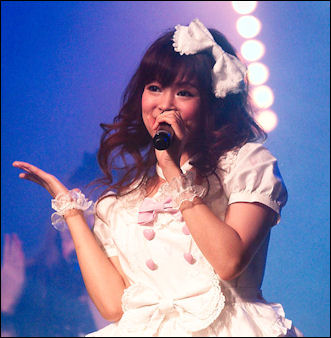
Japan Expo in 2011 Japan Day @ Central Park in New York drew 45,000 people in 2009. The New York Anime Festival in October 2010 attracted around 100,000 people. Puffy, Vamps — a new band featuring L'Arc-en-Ciel's Hyde — and Kanon of visual-kei sensations An Cafe appeared there. Sakura Con in Seattle also draws a large crowd.
In July 2011, an estimated 120,000 "anime" fans flocked to the Los Angeles Convention Center for the Anime Expo, an described as the largest convention of its kind in North America by its organizer, the Society for the Promotion of Japanese Animation. Highlights of the 20th annual event included autograph sessions, hundreds of exhibits, a cosplay contests, and several concerts, including the U.S. debut of the holographic "singer" Hatsune Miku. For many, seeing other fans embody their favorite characters is the main attraction. "I like the good deals on manga, but the cosplay is what draws you in," said fan Brittany Savage, 22. [Source: Kyodo, July 3, 2011]
Kyodo reportedThe event has come a long way from its beginning in Northern California in 1992. According to Marc Perez, chairman of the Society for the Promotion of Japanese Animation, Americans are being drawn to Japanese anime by the depth and sheer variety of the stories that appeal to all ages. And with the increased popularity has come increased availability. "The Japanese do recognize this is a bigger market, and it's also still a growing market," Perez said.
VIZ Cinema in San Francisco is the United States’ only movie theater devoted exclusively to Japanese film and anime. The 143-seat subterranean theater is located in the basement of the NEW PEOPLE building and features plush seating, digital as well as 35mm projection, and a THX®-certified sound system.
NEW PEOPLE offers the latest films, art, fashion and retail brands from Japan and is the creative vision of the J-Pop Center Project and VIZ Pictures, a distributor and producer of Japanese live action film. Located at 1746 Post Street, the 20,000 square foot structure features a striking 3-floor transparent glass façade that frames a fun and exotic new environment to engage the imagination into the 21st Century. A dedicated web site is also now available at:www.NewPeopleWorld.com http://www.newpeopleworld.com/ .
Baltimore Otakon

Japan Expo in 2011 The Otakon Anime Convention in Baltimore., the second largest anime and manga festival in the United States, drew about 30,000 people in 2010. Roland Kelts wrote in the Daily Yomiuri, “The scene beneath my floor-to-ceiling hotel windows was epic: A parade of multicolored costumed revelers coursed across an elevated walkway in the midmorning sun, some arm-in-arm, others wielding makeshift swords and other fake weaponry, most with an obvious skip in their step. [Source: Roland Kelts, Daily Yomiuri, August 5, 2011]
The temperature was above 38 C, the humidity numbing, and I watched with awe and a little trepidation. They were American otaku, cosplayers, anime fans and gamers, and they were headed to the Promised Land--in this case, the cavernous Baltimore Convention Center, host of the East Coast's largest anime convention, Otakon--and they were about 31,000 strong. The attendees were “primarily young, to be sure, most appearing to be in their teens and 20s, with a backdrop of middle-aged and older folks donning civilian wear. But they are nearly equal parts Caucasian, African-American, Latino and Asian, and females now seem to outnumber fanboys. There are so many of them, and they are so excited.”
Host cities benefit big-time from the cons in otherwise cash-strapped times. A local newspaper reported last weekend that Otakon brings an estimated 11.3 million dollars annually into the city of Baltimore. As I wrote in this column two months ago, the organizers of Sakuracon in Seattle calculate their contribution to that city's economy totaled 50 million dollars from 2006 to 2010.
Even so, anime and other pop culture industry skeptics point to less-than-stellar on-site sales as reasons to forgo paying for booths on the so-called dealers' floor (an unfortunate moniker that makes it sound like a narcotics den). But this seems short-sighted to me.
A majority of attendees may be mainly focused on camaraderie, celebration and showing off, but their passion is rooted in the media that first attracted them to the community. As they age, of course, they will likely have less time and more money. Attending a con may be impractical for them later in life, but the media will still be collectible.
J-Pop Summit Festival
New People, the multistory J-Pop shopping and entertainment complex launched in San Francisco's Japantown in 2009, hosts the J-Pop Summit Festival in August. "[The J-Pop Summit] is basically a street festival now," New People's Takeshi Yoshida explained to me at a recent meeting in Tokyo. "The [New People] building gives us a platform for the concept, which is to bring together people who have a new way of thinking. Japanese pop culture is a part of that, of course, but it's also a broader vision. Like Japan itself, it's about studying other cultures and creating something different, something fresh, from them."
New People's two-day J-Pop Summit already boasts impressive numbers: 30,000 attendees in 2009, then 40,000 in 2010 and an anticipated 50,000 to 60,000 in 2011. But Horibuchi's ultimate goal, Yoshida says, is to one day beat the annual Japan Expo in Paris, which last month brought together an estimated 200,000 fans of Japanese pop culture, outpacing even the United States' largest convention, Anime Expo in Los Angeles. Cultivating community by gathering fans seems like a habit worth forming.
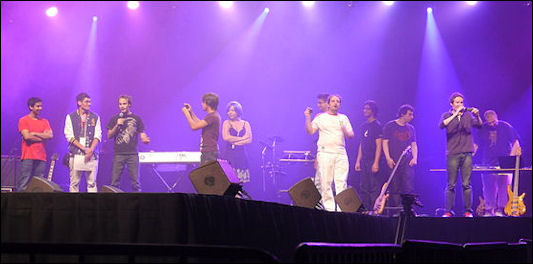
Japan Expo 2011 Otaku Music Show
Small Anime and Manga Events in the United States
Takamasa Sakurai wrote in The Daily Yomiuri, “In June, I visited Sacramento, Calif., after being invited to check out a Japanese pop culture event called Kintoki-Con.It was the first time for the event to be held, which was extremely valuable for me as I was able to see how well it was planned and run. I also discussed the event with the organizers who invited me.In the United States, similar events are held almost every week from early summer to autumn. Last year, I met a group of Americans who spend about a month during their summer holidays crisscrossing the country by bus to visit these events.
Organizers often find it difficult to invite topnotch guests to appear at their events, partly for financial reasons and partly because they lack connections. Kintoki-Con was a small event held in a corner of the Hyatt-Regency hotel. But the homey atmosphere was satisfying for both visitors and guests. Many people will never forget the heartwarming experience we felt. I pledged to myself that I would continue to support the event.
Anison Raves in the United States
Takamasa Sakurai wrote in the Daily Yomiuri, “It was at the Otakon anime convention, held in Baltimore, Md., in the summer of 2010, where I first experienced an anison rave. It was touching rather than surprising to find so many racially diverse young people dancing to Japanese anison all night. AnimeNEXT, an annual anime convention held in June in New Jersey, also hosted an anison rave. [Source: Takamasa Sakurai, The Daily Yomiuri, August 19, 2011]
When the DJ began his set after midnight, the 1,000-plus people who packed the hall turned the excitement level up to 11. Many AnimeNEXT participants stay in nearby hotels indulging in anime over the three-day convention in what is almost a camplike experience. As a Japanese, there is nothing that makes me happier than seeing young people from around the world sing and dance together to anison, giving them a small glimpse into Japan. I won't be alone in feeling sorry for someone who denies that anison brings people together and thinks this only affects the world of otaku, having nothing to do with them.
Otaku and Kawaii Frictions at American Anime Conventions
Japan Matsuri in Montpellier Freedom du Lac wrote in the Washington Post, “Men have long been the foundation of the genre’s fan base, but they’ve been joined in increasing numbers by teen girls, whose embrace of the medium’s more fantastical side has helped launch anime to new levels of stateside popularity. Conventions that were once cult gatherings attended almost exclusively by VHS-trading college-age (and older) males are now overflowing with young females, many of them sporting various iterations of anime’s popular doe-eyed, scantily clad look. [Source: J.Freedom du Lac, Washington Post, August 3, 2011]
At the Baltimore Otakon du Lac wrote, “There were people “cosplaying” — or costume-playing — characters from their favorite anime series and video games and sci-fi films. There were pirates and vampires and superheroes, along with a Rubik’s Cube and a My Little Pony. Everywhere you looked, there were older girls dressed as little girls and little girls dressed as littler girls — and grown men taking photos of all of them. Sometimes, the men asked for hugs, too.”
“There’s a little bit of perviness,” said Jamie Blanco, who was cosplaying a teenager from the hit anime series “Bleach.” (In real life, she’s in her 20s and the morning-drive producer for Federal News Radio.) The majority of people who attend anime conventions, she said, are there “because of a pure love” of the art form, its characters and stories. “But there are definitely a small percentage who come here to hug up on some of the younger girls — and younger boys.” At the trade bazaar in the bowels of the Convention Center, one could buy all the too-short schoolgirl outfits one would ever need. Also on offer: hentai, or pornographic comics, some of which leaned Lolita.
Older Men and Young Girls at Baltimore Otakon
Japan Matsuri in Montpellier Freedom du Lac wrote in the Washington Post: “Madoka! Madoka!” a man shouted, and the 16-year-old dressed as a 14-year-old Japanese cartoon schoolgirl stopped in the middle of the Baltimore Convention Center. “Can I take a picture?” She nodded, then struck a pose as Madoka Kaname, the “magical girl” character she was dressed as last weekend at Otakon, the annual festival of Japanese cartoons that once again turned the Inner Harbor into the epicenter of all things anime. [Source: J.Freedom du Lac, Washington Post, August 3, 2011]
Her costume included a Day-Glo pink wig with pigtails, white knee-high stockings, a red choker and a short pink-and-white dress that Little Bo Peep might have worn on a day she wanted to alarm her parents. The man, who appeared to be in his mid-30s, pointed his digital camera at the make-believe Madoka, snapped a photo . . . and then stared....And stared. “It can sometimes be very weird,” the teenager said of her convention encounters with overly interested older men. “But they really don’t mean any harm.”
Outside the Convention Center, cosplayers in animal outfits and gas masks and wigs generated triple takes (and occasional heckles) from drivers on Pratt Street. For Otakon attendees, it was business as usual. A man dressed in a “Pedobear” costume was there, portraying the creepy satirical mascot that first emerged on the Internet as a way to mock inappropriate behavior in anime Web forums. Pedobears are regulars at anime cons, where many attendees appear to be in on the joke.
“Everybody loves Pedobear,” Travon Smith, the 20-year-old Baltimore man inside the sweltering teddy-bear suit, said — while assuring anyone within earshot that he is not, in fact, a pedophile. He also is not endorsed by Otakon but came to the conference as a paid attendee. “It’s all a joke,” he said. “Just people having fun.” In his costume, Smith posed for photos and shook hands. People laughed. A young girl hugged Pedobear.
But an uncomfortable undercurrent is obvious. Just consider the visual snapshot of attendees at any anime convention now.”You get hundreds and hundreds of young girls in skimpy costumes . . . and then you have older male anime fans,” Diederichs said. “The juxtaposition of the two may not look entirely wholesome.
Con Perverts, the Darker Side of Anime Festivals
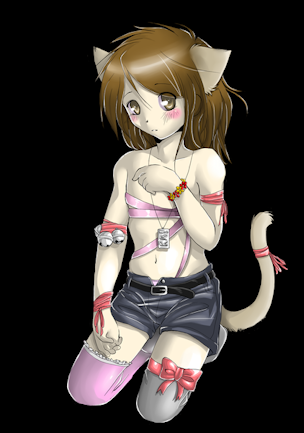
Freedom du Lac wrote in the Washington Post, The dark side of the new demographics has not gone unnoticed. “The Con perverts,” read the title of a Web forum thread that catalogued alleged stalking of minors at anime conventions. “Ever happen to you?” [Source: J.Freedom du Lac, Washington Post, August 3, 2011]
In July 2011, a 34-year-old Silver Spring man admitted in federal court that he had sex with a 13-year-old girl he met in February 2010 at Katsucon, an anime convention at the Gaylord Hotel at National Harbor in Prince George’s County. Michael A. Alper, who had previously been convicted of raping a 13-year-old in Virginia, pleaded guilty in U.S. District Court in Greenbelt to coercing and enticing a minor to engage in criminal sexual activity.
The Alper arrest and conviction became a hot topic among anime fans, some of whom fear being further stigmatized. (Many of them already think that other people consider them geeks who live in their parents’ basements.) “Leave it to the sickos to make the rest of us older guys that go to cons feel like eyeballs will be watching us double now,” one poster wrote on the Anime News Network forum. “I already have issues with going to cons and being the odd man out, and this guy has to make it just that much harder.”
This is a delicate time on the anime convention circuit, where the demographic shift has created an occasionally unseemly and sometimes dangerous dynamic. “I myself feel a little uncomfortable sometimes [at Katsucon] when I have to say to the third girl in a weekend who is wearing something too revealing, “Go back to your room and get more dressed.” “
In 1994, before anime moved in from the outer edges of fringe culture in the United States, David Stoliker attended the first Otakon. He has turned out every year since. He is 43 now, a physical therapist from Long Island. His summary of the demographic shift at Otakon: “There are definitely people who can wear skimpier costumes a little better.”
But don’t take that the wrong way, he said. Most of what happens at Otakon “isn’t prurient. It’s certainly not criminal.” An encounter like the one between a registered sex offender and a 13-year-old at Katsucon, he said, “can happen anywhere. People tend to draw attention to it when it happens in an unusual environment.”
Taking Measures Against Con Perverts
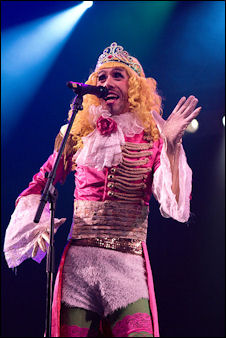
Freedom du Lac wrote in the Washington Post, The news of Alper’s arrest spurred Katsucon organizers to announce that they might begin checking their convention pre-registration list against sex-offender registries before their next event. Under the proposed policy, anybody listed on a published sex-offender registry would be denied entrance to Katsucon.” [Source: J.Freedom du Lac, Washington Post, August 3, 2011]
“We want to make sure we stay within the ethical and legal guidelines afforded to us in Maryland, but at the same time do everything in our power to protect our most vulnerable attendees,” Katsucon spokesman Chad Diederichs said.
Jennifer Piro, a member of the board of directors for Otakorp, the nonprofit group that produces Otakon, said that “no decision has been made” to introduce a similar policy at their convention. Otakon, she said, has taken precautions to protect minors. All attendees younger than 12, for instance, must be accompanied by a parent or guardian at all times, and adult-themed programming is presented late at night, for those with 18-and-over wristbands. But, Piro said, Otakon “is not a babysitting service.”
“We want to do everything we can to keep our attendees safe,” she said. “But there’s only so much you can do. . . . There are definitely sketchy people out there. They could be at the mall. They could be at McDonald’s. This is still the real world.” Said Katsucon’s Diederichs: “It does propagate a terrible stereotype that some people have about male fans that attend anime conventions.”
Image Sources: Wiki Commons
Text Sources: New York Times, Washington Post, Los Angeles Times, Times of London, Yomiuri Shimbun, Daily Yomiuri, Japan Times, Mainichi Shimbun, The Guardian, National Geographic, The New Yorker, Time, Newsweek, Reuters, AP, Lonely Planet Guides, Compton’s Encyclopedia and various books and other publications.
Last updated January 2013

